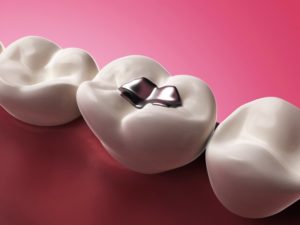Why Your Dentist Doesn’t Use Metal Fillings Anymore
January 8, 2020

When you visit your dentist in Northwest OKC for a checkup, one crucial purpose of the appointment is to check for cavities. If you have any, your dentist will have to prescribe a filling. More than 90% of the population has had a filling at some point. Bit what exactly are they made of? Metal amalgam fillings used to be quite common before composite resin became the modern standard. Let’s take a closer look at the history of fillings.
A Brief History of Metal Fillings
Around 1830, a dental restorative material known as amalgam was created in England and France, and quickly spread to the United States. Amalgam was composed of tin, silver, zinc, copper, and mercury. Within just a few years, controversy arose over the trace amounts of mercury in the fillings. People worried whether that mercury would seep into the patient’s system. In 1859, a new organization was formed as a result of the internal debate among dentists at the time as to whether amalgam should be used – the American Dental Association. They backed the idea that silver amalgam was the best material for fillings, as they still do to this day.
Why Metal Fillings Aren’t Common Anymore
In the past few decades, amalgam fillings have been linked to higher amounts of mercury in people’s systems. For this reason, dentists began finding other materials to fill cavities. The main one that stuck was called composite resin, a mixture of fine glass and acrylic particles that could be shaded to match the color of the existing tooth enamel.
Advantages of Composite Resin Fillings
Also called tooth-colored fillings, composite resin fillings, which are considered the gold standard by many dentists today, offer many advantages over traditional metal fillings, such as:
- As time passes, amalgam fillings can darken, leaving a noticeable metal spot in your tooth. Composite fillings blend right in with your smile.
- To make room for metal fillings, more enamel must be carved out. Because tooth-colored fillings bond directly to the tooth, you’re able to keep more of your natural tooth structure.
- The bond between the resin and the tooth is tight enough to seal out unwanted bacteria, preventing further decay.
- Tooth-colored fillings are a great alternative for patients who are allergic to metal.
As you can see, if you have a cavity these days, your dentist in Northwest OKC is much more likely to use a composite resin filling to heal your smile.
About the Author
Dr. Patrick Crowley is a graduate of the University of Oklahoma’s College of Dentistry. He is a member of several professional organizations including the American Dental Association, the Oklahoma Dental Association, and the Academy of General Dentistry. His special interest is in cosmetic dentistry, so you can trust that his practice offers fillings that will blend right in with your smile. To learn more, you can contact his office at (405) 751-5515.
No Comments
No comments yet.
RSS feed for comments on this post.
Sorry, the comment form is closed at this time.
